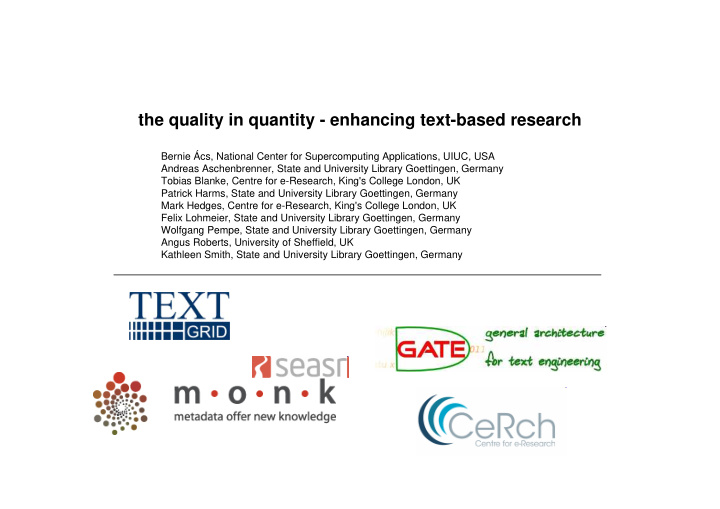



the quality in quantity - enhancing text-based research Bernie Ács, National Center for Supercomputing Applications, UIUC, USA Andreas Aschenbrenner, State and University Library Goettingen, Germany Tobias Blanke, Centre for e-Research, King's College London, UK Patrick Harms, State and University Library Goettingen, Germany Mark Hedges, Centre for e-Research, King's College London, UK Felix Lohmeier, State and University Library Goettingen, Germany Wolfgang Pempe, State and University Library Goettingen, Germany Angus Roberts, University of Sheffield, UK Kathleen Smith, State and University Library Goettingen, Germany
http://www.sixdifferentways.com/photos/spamalot-stairs.jpg
quantitative qualitative comparative [breadth] source as such [depth] • (statistical) evaluation • observing • information extraction • analyzing, understanding • re-representation / visualisation • annotating complimentary
12.02.2010 Developer Provider Content Scholar Tool TextGrid Architecture 4
TextGrid Services and Tools XML-Editor Metadata Annotator Graphical Link Editor Streaming Editor Workflow Editor Lemmatizer Search Tool Text Publisher Web Dictionary Search Tool Project Browser/ Navigator Collationer Tokenizer User and Project Management Sort Tool 5 12.02.2010
Ling. Annotations Image-Editor Quantitative An. External Services Services Internal Streamning ed Lemmatiser Collation Sorting Resources Fulltext – struktural Facsimile markup Volltext -Lemmatised Other sources Metadata -Morpho-syntact. Here -Dictionaries Here Goethe: Werther -Biblioanalytical. is is -Biograph. DB Here text Schiller: Wallenst Here -Named Entities text is -Encyclopedia is This …. text -Narratological This text is -… is -Thematic markup. text text . -- … .
SEASR / MONK SEASR (Software Environment for the Advancement of Scholarly Research) MONK (Metadata Offer New Knowledge) Andrew W. Mellon Foundation
Dunning Loglikelihood • Feature comparison of tokens • Specify an analysis document/collection • Specify a reference document/collection • Perform Statistics comparison using Dunning Loglikelihood Example showing over ‐ represented Example showing over ‐ represented Analysis Set: The Project Gutenberg EBook of A Tale Analysis Set: The Project Gutenberg EBook of A Tale of Two Cities, by Charles Dickens of Two Cities, by Charles Dickens Reference Set: The Project Gutenberg EBook of Reference Set: The Project Gutenberg EBook of Great Expectations, by Charles Dickens Great Expectations, by Charles Dickens
Text Clustering • Clustering of Text by token counts • Various filtering options for stop words, Part of Speech • Dendogram Visualization
Feature Lens “The discussion of the children introduces each of the short internal narratives. This champions the view that her method of repetition was patterned: controlled, intended, and a measured means to an end. It would have been impossible to discern through traditional reading“
Enables Scholar to Ask… Pattern identification using automated learning – Which patterns are characteristic of the English language? – Which patterns are characteristic of a particular author, work, topic, or time? – Which patterns based on words, phrases, sentences, etc. can be extracted from literary bodies? – Which patterns are identified based on grammar or plot constructs? – When are correlated patterns meaningful? – Can they be categorized based on specific criteria? – Can an author’s intent be identified given an extracted pattern?
Dunning Loglikelihood Tag Cloud • Words that are under-represented in writings by Victorian women as compared to Victorian men. • Results are loaded into Wordle for the tag cloud • —Sara Steger
why link qualitative and quantitative? they always have been linked ... • create (one) - validate (many) research hypothesis (extrapolate) • create (many) - validate (one) research hypothesis (replicate, show trends) • explain / illustrate a trend (many) through individual examples (one) • analyze an observation (one) through statistical analyses (many)
research lifecycle discover integrate prepare drill- enquiry synthesize down validate analyze collate inspired by http://www.archimuse.com/papers/ukoln98paper/section6.html
research lifecycle discover integrate prepare prepare context- drill- explore ualize enquiry enquiry re-represent down validate validate visualize analyze collate inspired by http://www.archimuse.com/papers/ukoln98paper/section6.html
finally • challenges: 1. get the data (automatic harvest or manual selection/upload?) 2. integrate/normalise the data (semi-automatic?) 3. get the analysis/visualisation right, along which dimensions? • cue for the architecture: data will be redundant, to reuse existing systems and be open: (a) active use, (b) various analysis frameworks, (c) preservation • usability: hide complexity ! immediate results (automatic), and allow refinement (user)
Recommend
More recommend